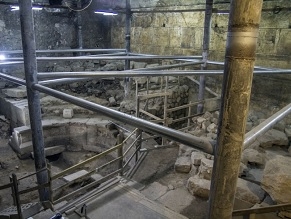|
World Jewish News

General view of the Wilson’s Arch excavation. Photograph: Yaniv Berman, courtesy of the Israel Antiquities Authority.
|
Excavations conducted in Jerusalem uncover large portions of courses of the Western Wall that have been hidden for 1,700 years.
18.10.2017, Israel Excavations conducted by the Israel Antiquities Authority, with the participation of volunteers, have uncovered in Jerusalem large portions of courses of the Western Wall that have been hidden for 1,700 years. An ancient Roman theater-like structure was exposed for the first time.
The dramatic discoveries will be presented to the public for the first time at the conference titled “New Studies in the Archaeology of Jerusalem and its Environs,” to be held this week in Jerusalem, marking 50 years of archaeological research since the reunification of the city.
The eight stone courses of the Western Wall that had been buried under an 8-meter layer of earth were recently uncovered in excavations conducted by the Israel Antiquities Authority in the Western Wall Tunnels. These stone courses, completely preserved, are built of massive stones and are outstanding in the quality of their construction.
Furthermore, after the removal of this layer of soil, the archaeologists were surprised to discover that it covered the remnants of an extraordinary theater-like structure from the Roman period confirming historical writings that describe a theater near the Temple Mount.
At a press conference, Jerusalem District Archaeologist of the Israel Antiquities Authority Dr. Yuval Baruch said the theater is the public building that scholars have been seeking since archeological research began in Jerusalem over 150 years ago.
“The new finding prove the importance Jerusalem had as Roman colony of Aelia Capitolina. Descriptions of theater-like structures are found in written sources like Josephus Flavius, many theories were advanced about the location of these complexes. This is the first one we’ve found in Jerusalem,” Baruch said.
Apparently, a great deal was invested in the construction of the theater which contained approximately 200 seats.
From the very beginning of archaeological research in Jerusalem over 150 years ago, scholars have been seeking the public buildings mentioned in the historical sources. Particularly prominent among them, theaters or theater-like structures are mentioned. These descriptions are found in written sources from the Second Temple period (such as Josephus Flavius), and in sources from the period following the destruction of the Second Temple, when Jerusalem became the Roman colony of Aelia Capitolina. Many theories were advanced as to the location of these complexes, but they were without archaeological foundation. That is, until this latest discovery.
Wilson’s Arch is in fact the only intact, visible structure remaining from the Temple Mount compound of the Second Temple period. The arch, built of enormous stones, is the last of a series of such arches that once constituted a gigantic bridge leading to the Temple Mount from the west.
The arch stands high above the foundations of the Western Wall, and it served, among other purposes, as a passageway for people entering the Temple Mount compound and the Temple. A huge aqueduct also passed over the arch.
According to site excavators Dr. Joe Uziel, Tehillah Lieberman and Dr. Avi Solomon: “From a research perspective, this is a sensational find. The discovery was a real surprise. When we started excavating, our goal was to date Wilson’s Arch. We did not imagine that a window would open for us onto the mystery of Jerusalem’s lost theater. Like much of archaeological research, the expectation is that a certain thing will be found, but at the end of the process other findings, surprising and thought-provoking, are unearthed. There is no doubt that the exposure of the courses of the Western Wall and the components of Wilson’s Arch are thrilling discoveries that contribute to our understanding of Jerusalem. But the discovery of the theater-like structure is the real drama.”
The archaeologists believe the theater was never used. A number of findings at the site indicate this – among them a staircase that was never completely hewn. It is clear that great effort was invested in the building’s construction but oddly, it was abandoned before it was put to use. The reasons for this are unknown, but they may have been connected to a significant historical event, perhaps the Bar Kokhba Revolt: construction of the building may have been started, but abandoned when the revolt broke out. Additional evidence of unfinished buildings from this period has been uncovered in the past in the excavations of the Eastern Cardo in the Western Wall Plaza.
Rabbi Shmuel Rabinovitch, rabbi of the Western Wall and the holy places said: “Time after time the amazing archaeological findings allow our generation to actually touch the ancient history of our people and Jewish heritage and its deep connection to Jerusalem. Each finding thrills me to new and powerful heights. We have a great deal of archaeological work ahead and I am certain that the deeper we dig, the earlier the periods we will reach, further anchoring the profound connection of the Jewish people to the Land of Israel and to Jerusalem.”
EJP
|
|
